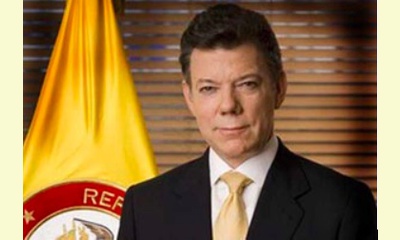|
|
Colombia awakens to hopes for peace with the re-election of their president
un articulo por Maylín Vidal, Prensa Latina
Colombians awoke day today [June 16] with a new hope to gain
peace after the victory in the presidential elections of President Juan
Manuel Santos, who pledged to work the next four years to build a
new country.
click on photo to enlarge
In the second round of elections, in which Santos won with 50.59
percent of the votes against the Democratic representative Oscar
Iván Zuluaga (45 percent) Center, the voters celebrated the
possibility of continuing the process of peace that would end a war
that has been going on over half a century.
The early ending of the conflict was the main campaign issue of the
president, who received support from leftist groups, trade
unionists, peasants and youth. Although they do not share all of
the proposals of the new government, they bet on peace and
reconciliation .
For more than a year and a half the government been engaged with
the guerrillas of the Revolutionary Armed Forces of Colombia-
People's Army (FARC-EP) in a dialogue in Cuba and they have
arrived at partial agreements, having signed three of the five points,
considered to be historic advances for the country..
A large majority of Colombians and political analysts believe that
these developments, together with the notice of initiation of
exploratory talks with the National Liberation Army (ELN), are
irreversible.
In his first speech after the election, the president said "Unity has
triumphed today as millions of our fellow citizens have supported a
dream we shared by voting for the vision of changing fear to hope.
He made these remarks in his campaign headquarters decorated
with slogans like " Colombia wants peace, if you can."
"This is the end of over 50 years of violence and the beginning of a
new country with more freedom and social justice," he said.
In social networks, Colombians agree that to gain a lasting peace, it
now depends on everyone.
(Click here for a Spanish version of this article)
|








|
DISCUSSION
Pregunta(s) relacionada(s) al artículo :
What is happening in Colombia, Is peace possible?
* * * * *
Comentario más reciente:
The force of non-violence constrains the force of arms!
Colombia - the force of peaceful resistance -
At the beginning of July, the rebels of the armed revolutionary forces of Colombia (FARC) kidnapped a 51 year old Swiss, and his Colombian assistant who worked in the Indian communities of Cauca province where they were setting up development projects by building schools and community production enterprises.
The news of the kidnapping was spread through all the villages and 2000 Indians set out to pursue the 400 guerillas. They reached them at an elevation of over 4000 meters (12,000 feet), encircled them, and without any weapon, constrained them to release the 2 hostages! (After 2 days, the hostages were released).
This release, obtained through "peaceful resistance" has raised a national debate: the possibility of resisting violence without needing to use weapons has demonstrated the effectiveness of human solidarity movements.
"I will return, and I will then be millions" prophesied the Aymara Indian leader Tapak Katari, in 1781, at the time of his execution by the Spanish conquistadors.
100 million in 1492, the Indians were no more than 4,5 million one century and half later. Currently there are 44 million Indians populating Latin America.
In spite of their great diversity, the Indian movements take on more and more importance. In Ecuador, Guatemala, Bolivia, Peru, Mexico or Colombie they are opposed to the neoliberal system that governs the Americas, while protesting against the imposition of the American economic market. . ... continuación.

|
|









